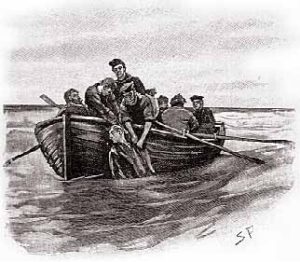
“The Adventure of the Gloria Scott” takes place during Sherlock Holmes’s college days. In the story, Holmes tells Watson about a college friend of his and the curious events leading up to the death of his friend’s father. Holmes met his friend Victor Trevor when Trevor’s dog bit and injured Sherlock. Trevor visits Holmes while he is convalescing, and the two become friends. Trevor invites Holmes to his father’s house in Norfolk, and Holmes quickly surprises the elder Mr. Trevor with some deductions about the man’s past. A strange visitor arrives, and Victor Trevor is shocked by his father’s meek behavior around the stranger. A couple of months later, Trevor tells Holmes that his father has had a stroke and is at death’s door. The elder Mr. Trevor’s last words directed his son to hidden papers in his Japanese cabinet, and Holmes finds an encrypted message that he deciphers indicating the elder Mr. Trevor may have feared for his life. The papers in the Japanese cabinet reveal a secret identity and mysterious past Mr. Trevor has long kept quiet—at the center of the story is a long-lost ship called the Gloria Scott.
“The Adventure of the Gloria Scott” takes place first chronologically in the Sherlock Holmes canon, but it was actually the 19th Holmes story published, first in The Strand magazine and later collected in The Memoirs of Sherlock Holmes. Sherlock Holmes tells Watson that it is his “first case,” and indeed Mr. Trevor, impressed with Sherlock’s deductive reasoning, suggests that he take it up as a career, at which point Sherlock Holmes realizes he might turn what he believes is a hobby into an occupation. It’s not, strictly speaking, a real case. Holmes does make some accurate deductions about Mr. Trevor’s past, and he does decode a message received by Mr. Trevor, but there is no real crime to be solved in the end, as Mr. Trevor’s papers turn out to be a confession of his entire past, and the looming threat that drove Mr. Trevor to have a stroke vanishes after Mr. Trevor’s death.
In the updated series Sherlock, Mary Morstan (then John Watson’s fiancée) decodes a text message by reading every third word, as Sherlock does with the message Mr. Trevor receives (season three, “The Empty Hearse”), but allusions to the Gloria Scott appeared in last night’s episode, “The Lying Detective,” too. Sherlock makes a series of deductions about one of his potential clients, and one is very similar to the deduction that Sherlock Holmes makes about Mr. Trevor’s tattoo in this story. A more tenuous connection may be the moment when that episode’s villain, Culverton Smith, says that three recording devices were found and removed from Sherlock’s effects in his hospital room, and Sherlock remarks that people always stop at three—so satisfying—before revealing he had a fourth device. That last reference might be a stretch. I’m not sure the number three on its own is a true reference to this story. The confession of Mr. Trevor might be considered similar to Culverton Smith’s confession, but I admit that’s a stretch, too, especially as Culverton Smith is much more evil than Mr. Trevor, and he also has a perverse need to confess that even prompts him to use memory-altering drugs on his friends just so he can confess his crimes to them in a way they won’t remember. A stronger connection might be to Mary Watson’s secret past as a hired assassin—her criminal past catches up with her in a way not too dissimilar from that of Mr. Trevor’s.
Update 1/16/17: Season 4, episode 3 of Sherlock was just broadcast last night, and now that the debriefs with spoilers are online, I feel I can update this post to add the reference to “The Adventure of the Gloria Scott” that I noticed in “The Final Problem.” Sherlock’s sister murders Sherlock’s first friend, whom Sherlock initially thinks was a dog named Redbeard—he has blocked out memories of the friend due to the trauma of the event. His friend was a boy named Victor Trevor, and Sherlock had not been able emotionally to establish a friendship after Victor’s disappearance and death at the hands of his sister until he meets John Watson. He also refers to the missing Victor Trevor as “his first case,” as he does with “The Gloria Scott.” Wonderful that the writers of Sherlock have gone back to the first two chronological stories in this season, especially as many think it might be the last season of the show. I have also updated my review of “The Musgrave Ritual” to reflect references in last night’s Sherlock.
I had to do some digging online because I wondered if the mysterious Mr. Hudson was perhaps landlady Mrs. Hudson’s husband or some other relative, but it seems Doyle just used the name for two characters. As Sherlock Holmes stories go, the long confession as a means of resolution and the lack of a real case or mystery as a result made this one a bit of a dud for me. It was interesting to see Sherlock Holmes’s early deduction skills, but apart from that, it’s not very much fun when the mystery isn’t really solved by Sherlock. The multiple frames are not really confusing, but overcomplicate the story. Watson is relating the story to us. Sherlock is telling the story to Watson. And Sherlock is recalling Mr. Trevor’s story as he read it in his papers. The quotation marks get a little creative! Still, it’s not a bad story.
Rating:




 I have figured out the Chronological Sherlock Holmes Challenge and am in the process of making up for lost time, as I read A Study in Scarlet first instead of this story. This week’s story is “The Musgrave Ritual,” so look for my thoughts on that story by the end of this week.
I have figured out the Chronological Sherlock Holmes Challenge and am in the process of making up for lost time, as I read A Study in Scarlet first instead of this story. This week’s story is “The Musgrave Ritual,” so look for my thoughts on that story by the end of this week.